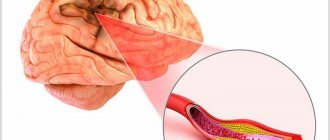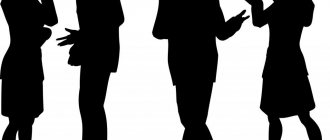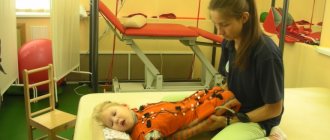Transient ischemic attacks, stroke and other brain damage can lead to the development of aphasia. The main symptom of this pathology is acquired speech disorders of varying severity. The disease develops as a result of damage to areas of the central nervous system responsible for speech function. Amnestic aphasia is observed when the parietal or temporal region of the cerebral cortex is damaged and is associated with the patient’s inability to name an object while maintaining the ability to describe it. Diagnosis and treatment of pathology is complex. Therapy uses medications, as well as long-term speech and social rehabilitation.
About the disease and its classification
Aphasia is manifested by speech impairment as a result of organic damage to nervous tissue in various parts of the brain. The localization of the damaged area determines the clinical manifestations of the disease. Based on the nature of the speech disorder, neurologist A.R. Luria identified several types of aphasia:
- Motor, which is further divided into efferent and afferent. Appears when the pre- and postcentral gyri are damaged. Characterized by difficulties in selecting the correct sounds and disruption of the motor articulation process.
- Sensory, manifested by a violation of the perception of the speech of others and one’s own, as a result of which it becomes illegible and ungrammatical. Develops in patients with damage to Wernicke's center.
- Acoustic-mnestic occurs in patients with damage to the fibers connecting the hippocampus, responsible for memory, with the auditory cortex. The patients' speech is poor, with a large number of omissions of nouns and paraphrases.
- Semantic aphasia occurs when the frontal areas of the cerebral cortex are damaged. A person stops understanding complex grammatical structures and begins to use simple sentences in his speech.
- Amnestic, characterized by the patient’s inability to name a specific object. Occurs with damage to the temporal and parietal parts of the brain.
Amnestic aphasia occurs in 5-10% of patients with damage to the cerebral cortex. The disease leads to a decrease in the level of quality of life due to difficulty communicating with other people. In addition, difficulties arise in the patient’s professional life and the likelihood of loss of ability to work.
Main reasons
The occurrence of amnestic aphasia is observed when the brain is exposed to any damaging factors. It should be noted that for right-handed people to experience symptoms, the damage must be localized in the left hemisphere, while for left-handed people the opposite is true. The main causes of organic changes in the central nervous system include:
- traumatic brain injuries occurring as a result of a traffic accident or a direct blow to the temporal or parietal region (such an impact causes mechanical damage to the nervous tissue);
- encephalitis and meningitis, characterized by the development of purulent or serous inflammation and destruction of nerve cells, as well as their fibers (observed with bacterial, viral or fungal infection);
- benign or malignant tumors with intracranial localization;
- surgical interventions performed in the area of the temporal and parietal cortex (when removing tumors, vascular aneurysms and other formations, damage to the functional cortical areas responsible for speech is possible);
- transient ischemic attacks and strokes of any type, manifested by necrosis of certain areas of the cerebral cortex;
- acute intoxication with poisons and drugs (similar changes develop against the background of liver and kidney failure, due to the accumulation of toxic metabolic products in the blood);
- neurodegenerative diseases - Pick's disease and Alzheimer's disease, characterized by the gradual destruction of neurons in the cerebral cortex.
In addition to these reasons, there are predisposing factors to the development of amnestic aphasia. These include hereditary predisposition and old age.
What is amnestic aphasia?
Aphasia is a neurological disease of organic nature, which is formed as a result of the death of neurons located in the cerebral cortex area, responsible for the synthesis and formation of speech function, as well as the perception of speech and non-verbal signals of surrounding people. Aphasia is always an acquired pathology, i.e. it is observed in people with initially normally functioning speech function, so it is important not to confuse aphasia with alalia if the disease is observed in childhood.
A wide range of reasons can lead to the development of pathology, but the final pathogenetic mechanism of this disease is the same and consists in extensive death of nervous tissue localized in specific areas of the brain responsible for speech.
Clinical manifestations
Symptoms of amnestic aphasia develop slowly, and therefore the patient himself and his loved ones may not be aware of the disease for a long time. The periodic inability to name an object is often associated with a person's age, which leads to a late diagnosis. The main clinical manifestations include the following clinical signs:
- a person cannot name an object, however, he can easily describe its external characteristics and purpose;
- due to the difficulty of selecting the names of things, the patient’s speech is slow and has a large number of pauses (the opposite situation may be observed - fluent speech with frequent errors in the use of words);
- repetition of the same words and phrases (typically a large number of descriptive constructions and paraphrases);
- the number of nouns decreases (most often, speech consists of adjectives that describe an object);
- speech is logical and grammatically correct;
- reading and writing skills do not suffer and remain at the same level;
- the pronunciation of sounds and their combinations does not change;
- articulation changes are not detected.
Amnestic aphasia is characterized by the inability to retain the name of an object. As a result, the patient uses complex descriptive constructions consisting mainly of adjectives. It is this feature of speech that allows one to suspect a disease and seek medical help.
MOTOR APHASIA OF AFFERENT TYPE
Stage of severe disorders
1. Overcoming disorders of understanding situational and everyday speech:
- display of pictures and real images of the most commonly used objects and simple actions by their names, categorical and other characteristics. For example: “Show a table, a cup, a dog, etc.”, “Show pieces of furniture, clothing, transport, etc.” “Show someone who flies, who talks, who sings, who has a tail, etc.”
— classification of words by topic (for example: “Clothing”, “Furniture”, etc.) based on a subject picture;
— answers with an affirmative or negative gesture to simple situational questions. For example, “Is it winter now, summer..?”; "You live in Moscow?" and etc.
2. Disinhibition of the pronunciation side of speech:
- conjugate, reflected and independent pronunciation of automated speech series (ordinal counting, days of the week, months in order, singing with words, ending proverbs and phrases with a “hard” context), modeling situations that stimulate the pronunciation of onomatopoeic pronouns (“ah!” “oh” !" and so on.);
- conjugate and reflected pronunciation of simple words and phrases;
- inhibition of the speech embolus by introducing it into a word (ta, ta..-Tata, so), or into a phrase (ma..ma-mama...; this is mom).
3. Stimulating simple communicative types of speech:
— answers to questions in one or two words in a simple situational dialogue;
— modeling situations that contribute to the evocation of communicatively significant words (yes, no, want, will, etc.);
— answers to situational questions and composing simple phrases using a pictogram and a gesture accompanied by the pronunciation of simple words and phrases.
4. Stimulating global reading and writing:
— laying out captions under pictures (subject and subject);
- writing the most common words-ideograms, copying simple texts;
— conjugate reading of simple dialogues.
Moderate stage of disorders
1. Overcoming disorders of the pronunciation side of speech:
- isolating sounds from words;
— automation of individual articles in words with different syllabic structures;
— overcoming literal paraphasias by selecting first discrete and then gradually converging sounds in articulation.
2. Restoration and correction of phrasal speech:
- composing phrases based on a plot picture: from simple models (subject-predicate, subject-predicate-object) to more complex ones, including objects with prepositions, negative words, etc.;
- composing phrases on questions, on key words;
- exteriorization of grammatical-semantic connections of the predicate: “who?”, “why?”, “when?”, “where?” etc.;
— filling in gaps in a phrase with a grammatical change in a word;
— detailed answers to questions;
- compiling stories based on a series of plot pictures;
- retelling texts based on questions.
3. Work on the semantics of the word:
— development of generalized concepts;
- semantic play on words (subject and verbal vocabulary) by including them in various semantic contexts;
— filling in the gaps in a phrase;
- completing sentences with different words that are appropriate in meaning;
- selection of antonyms, synonyms.
4. Restoration of analytical-synthetic writing and reading:
- the sound-letter composition of the word, its analysis (one-two-three-syllable words) based on diagrams that convey the syllabic and sound-letter structure of the word, a gradual reduction in the number of external supports;
- filling in missing letters and syllables in words;
- copying words, phrases and small texts with an emphasis on self-control and independent error correction;>
- reading and writing from dictation of words with a gradually more complex sound structure, simple phrases, as well as individual syllables and letters;
- filling in missing words in texts when reading and writing, practiced in oral speech.
Stage of mild disorders
1. Further correction of the pronunciation aspect of speech:
— clarification with articles of individual sounds, especially affricates and diphthongs;
— differentiation of acoustic and kinesthetic images that are similar in articulation of sounds in order to eliminate literal paraphasias;
- practicing the purity of pronunciation of individual sounds in a sound stream, in phrases, with a combination of consonant sounds, in tongue twisters, etc.
2. Formation of detailed speech, complicated in semantic and syntactic structure:
- filling in the missing main sentence, as well as a subordinate sentence or subordinating conjunction in a complex sentence;
- answering questions with complex sentences;
- retelling texts without relying on questions;
— drawing up detailed plans for texts;
— preparation of thematic messages (short reports);
- speech improvisations on a given topic.
3. Further work to restore the semantic structure of the word:
- interpretation of individual words, mainly with abstract meaning;
— explanation of homonyms, metaphors, proverbs, phraseological units.
4. Work on understanding complex logical and grammatical figures of speech:
— execution of instructions, including logical and grammatical phrases;
— introduction of additional words, pictures, questions that facilitate the perception of complex speech structures.
5. Further restoration of reading and writing:
- reading and retelling expanded texts;
- dictations;
— written presentation of texts;
— writing letters, greeting cards, etc.;
- essays on a given topic.
1) Restoring the “articuleme-phoneme” connection
- writing letters corresponding to the names of sounds in expressive speech, reading these letters immediately after writing;
- isolating the first sound from simple words, fixing attention on the articulatory, acoustic, and then graphic image of this sound; independent selection of words for this sound and writing them;
- writing practiced sounds and syllables under dictation;
— identification of letters in different fonts;
— finding given letters in various texts (underlining, writing out).
2) Restoring the ability to sound-letter analysis of the composition of a word:
- dividing words into syllables, syllables into letters (sounds) based on various graphic schemes;
- highlighting any sound in a word;
- recalculation and listing of words by letter (orally);
- filling in gaps in words;
- writing words from letters given separately.
3) Restoring the skill of detailed written speech:
- writing words of different sound structures with and without support from an object picture: a) under dictation, b) when naming an object or action;
- writing proposals: a) from memory, b) from dictation, c) in the form of a written statement based on a plot picture for the purpose of communication with others;
- written statements and essays.
Diagnostic measures
Diagnostics and treatment are handled by two specialists - a psychiatrist and a neurologist. Under no circumstances should you make a diagnosis or select therapy on your own. This can cause rapid progression of the underlying disease and the development of its complications. In medical institutions, the patient is examined according to the following algorithm:
- The patient's complaints, as well as anamnesis of life and illness, are collected. The specialist identifies factors and possible causes of brain damage. In most cases, it is necessary to additionally talk with loved ones.
- General clinical examinations: general and biochemical blood tests, general urinalysis, electrocardiogram, etc.
- Due to the presence of cognitive impairment, all patients are prescribed neuropsychological diagnostics based on the study of memory, attention, ability to perceive information, etc. Such methods make it possible to clarify the nature of the speech disorder, as well as to suggest the localization of the lesion in the brain.
- Computed or magnetic resonance imaging is used to study the structures of the central nervous system. The doctor has the opportunity to assess their integrity and identify areas of damage to the nervous tissue.
- If a traumatic brain injury is suspected, an X-ray examination of the skull is performed. The method allows you to identify damage to bone structures that indicate a head injury.
- In the case of neuroinfections, an enzyme-linked immunosorbent assay (ELISA) or polymerase chain reaction (PCR) of the patient’s blood and cerebrospinal fluid is performed to identify the pathogenic microorganism.
- Ultrasound and Doppler mapping of the cervical and cerebral vessels are used if symptoms are suspected of being ischemic. During the examination, the doctor can determine narrowing of the arteries, the formation of aneurysms, malformations, etc.
An integrated approach to diagnostics allows us to determine the exact location of brain damage and make an accurate diagnosis.
Diagnostics
Amnestic aphasia is a disease that lies at the intersection of two areas: neurology and psychology. Since aphasia is characterized by various disorders of the cognitive function of the brain, such disorders cannot but be accompanied by mental defects. Neuropsychological diagnostic methods are used to identify amnestic aphasia. To verify the disease and clarify the degree of impairment of the functional activity of the speech apparatus of a sick person, they resort to the use of special tests. Typically, such tests use a variety of objects with varying degrees of difficulty in pronouncing their names. There are also tests of a descriptive nature, when the patient is told about the characteristics of an object and see if the patient can answer with hints. A number of tests determine the connection between speech and visual manifestations, for example, the patient is sequentially shown several objects belonging to the same category; if the patient does not respond, then he has a violation of the connection between speech function and visual images, which can be interpreted in favor of sensory-amnestic aphasia.
In addition to special neurological and psychological tests, each patient is required to undergo laboratory and instrumental research methods. Depending on the cause of aphasia, diagnostic methods will be more or less informative.
The Clinical Brain Institute has a high-tech diagnostic department, which can conduct research such as:
- Tomographic studies: computed tomography and magnetic resonance imaging with and without contrast;
- X-ray examination of the skull and brain to identify defects;
- Ultrasound sonography and Doppler mapping of neck vessels;
- Comprehensive laboratory diagnostics.
In addition to high-quality equipment, a specialist is no less important for diagnostic purposes. The diagnostic department employs highly qualified specialists certified in related fields of medicine, which increases the efficiency of the diagnostic search and subsequent treatment of each individual patient.
Effective treatment
The main goal of therapy is to eliminate the underlying factor that led to the development of the disease. If tumor formations, hematomas and other space-occupying structures are detected, the patient is indicated for neurosurgical intervention with their removal. For neuroinfections, etiotropic therapy is prescribed - antibacterial, antifungal or antiviral drugs.
Treatment of amnestic aphasia and elimination of its symptoms includes medicinal and non-medicinal types of treatment. The following drugs are chosen among the medicines:
- nootropics (Phenotropil, Piracetam, etc.), which improve metabolism in the nervous tissue and help improve cognitive functions;
- medications that improve cerebral circulation: Actovegin, Cerebrolysin and their analogues (increase the delivery of nutrients and oxygen through the blood to the cerebral cortex, which has a positive effect on a person’s cognitive skills).
Any medications should only be prescribed by a doctor. All medications have a number of contraindications for their use, which should be taken into account when selecting treatment. Otherwise, the patient may experience side effects from the medications. In addition to medication, methods of non-invasive brain stimulation using magnetic fields or weak electric current are used. Such procedures improve the functioning of nervous tissue and improve cognitive skills.
Rehabilitation activities
Correct and comprehensive rehabilitation is of greatest importance in the correction of amnestic aphasia. Training aimed at restoring speech and other skills takes place in several stages:
- First, the patient is taught to work with objects through their visual image. To do this, use cards with an image and its name. This allows you to associate a certain visual image of an object and function with its name.
- At the second stage, the emphasis in rehabilitation is on the restoration of situationally determined speech. The patient is given a set of classes, including on-site orientation with verbal instructions from a specialist, and discussion of various everyday topics. To consolidate the results obtained, self-testing, questionnaires and classes with rehabilitation specialists are carried out.
- The last stage is aimed at improving visual and auditory-verbal memory. The patient is asked to solve crosswords and riddles, retell passages from books or conversations, and write stories. Conduct classes to improve factual memory by remembering important dates, addresses and other information. Communication with loved ones is important, since active speech and its perception help the patient restore the functions of various parts of the brain.
In addition to these activities, all patients need constant work activity, reading books and attending physical therapy classes. The rehabilitation process lasts from several months to several years, depending on the severity of the brain damage.
ACOUSTIC-MNESTIC APHASIA
Stage of disorders of moderate and mild severity
1. Expanding the scope of auditory perception:
— display of objects (real and in pictures) by name, presented in pairs, triplets, etc.;
- showing body parts according to the same principle;
— implementation of 2-3-level oral instructions;
— answers to detailed questions, complicated by syntactic structure;
- listening to texts consisting of several sentences and answering questions about the content of the texts;
- writing from dictation with a gradual increase in phrases;
- reading gradually increasing phrases, followed by reproduction (from memory) of each of the sentences and the entire set as a whole.
2. Overcoming weakness of auditory-speech traces:
- repetition from memory of read letters, words, phrases with a gradual increase in the time interval between reading and reproduction, as well as filling the pause with some other type of activity;
— memorizing short poems and prose texts;
— repeated display of objects and pictures after 5-10 seconds, after 1 minute. after the first presentation;
- reading texts with time-delayed retelling (after 10 minutes, 30 minutes, the next day, etc.);
- composing orally sentences using reference words perceived visually;
- listing words by letter with a gradually more complex sound structure, and gradually moving away from the written example of these words.
3. Overcoming naming difficulties:
- analysis of visual images and independent drawing of objects denoted by name words;
- semantic play in contexts of various types of words denoting objects, actions and attributes of objects;
— classification of words with independent finding of a generalizing word;
— exercises on the interpretation of words with concrete, abstract and figurative meaning.
4. Organization of a detailed statement:
- compiling a story based on a series of plot pictures;
- retelling of texts, first according to a detailed plan, then according to a condensed plan, then without a plan;
- extensive dialogues on non-situational topics (professional, social, etc.); practicing samples of communicative and narrative writing (greeting cards, letters, statements, essays on a given topic, etc.).
How to prevent the development of the disease
Prevention of amnestic aphasia is based on preventive measures that cause damage to the structures of the central nervous system. This includes the following medical recommendations:
- avoid situations that can lead to traumatic brain injuries (use a helmet and other protective equipment when engaging in hazardous sports);
- if you have a disease of the cardiovascular system or other internal organs, follow the doctor’s instructions and do not self-medicate;
- after neurosurgical operations, undergo full rehabilitation measures aimed at restoring cognitive skills;
- regularly engage in sports, including aerobic exercise and strength training;
- eliminate bad habits - drinking alcohol and smoking;
- normalize the diet by excluding from it all fatty, salty, smoked foods, and increasing the proportion of lean meats (chicken, rabbit), fish, fruits, vegetables and berries;
- in old age, continue to read books, learn poetry, do handicrafts and other hobbies (such activities prevent the development of Alzheimer's disease and Pick's disease).
If you detect any signs of amnestic aphasia in yourself or a close relative, you should immediately seek medical help. The pathology is treated by a neurologist or psychiatrist. In the absence of these specialists, it is necessary to visit a therapist who will conduct an initial diagnosis and refer the patient for further consultation to specialized medical institutions.
The prognosis depends on the degree of damage to the nerve tissue and the time of initiation of treatment and rehabilitation. With a small affected area and early initiation of therapy, the patient gradually recovers normal speech and other cognitive skills. If treatment is started late, its effectiveness is limited. Residual speech defects of varying severity are possible. The support of loved ones who are directly involved in the rehabilitation of the patient is important in eliminating aphasia.
Prognosis and prevention
Speech therapy correction of this disorder takes a lot of time. Not only the doctor, but also the speech therapist and the patient’s relatives should take part in it. The earlier treatment is started, the greater the chances of success. How much the patient’s speech will be restored depends on the size and location of the affected area in the brain, age and other factors that were described above.
Most often, young patients recover. But, if this diagnosis was made to a 5-7 year old child, then speech may be completely lost, or the prognosis is a severe violation of speech development. Motor aphasia can end spontaneously in patients of any age, turning into stuttering.
Preventive measures include timely diagnosis of brain tumors and their adequate treatment; in the prevention of traumatic brain injuries, in the prevention of cerebrovascular accidents.









